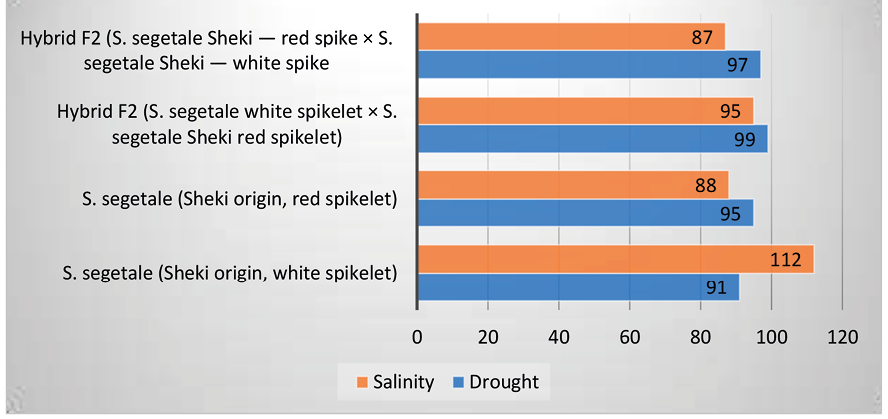Introduction
S. segetale (Zhuk.) (Sheki), known for its seeds’ rich chemical composition, is an important agricultural crop. Its origin is traced to the mountainous regions of Transcaucasia and adjacent areas of Central Asia [1, p. 57-63]. Compared to other crops, wheat demands less fertile soil, adapts quickly to growing conditions, and shows resistance to diseases. For these reasons, rye is often used as a donor in breeding programs aimed at developing new wheat genotypes [2, p. 60-61].
The protein content in rye grains contains higher levels of certain amino acids–such as lysine, arginine, valine, and threonine-compared to wheat proteins. However, both the quantity and quality of protein in grains can vary due to factors like climate, soil conditions, and cultivation practices [3, p.37-43].
As an outcrossing species, rye presents challenges for producing genetically stable pure lines, complicating its use in breeding and genetic studies.
The aim of this study was to investigate the stress tolerance (drought and salinity) and yield components of two parental forms of S. segetale (Sheki) and their two second-generation hybrid forms:
hybrid F2 (S. segetale Sheki – – white spike × S. segetale red grain)
and hybrid F2 (S. segetale Sheki – red grain × × S. segetale Sheki – white spike).
Materials and methods of research
Stress tolerance was assessed using various diagnostic methods, including measurements of total water content, leaf water retention capacity, and changes in chlorophyll (a+b) and carotenoid contents under stress conditions [4, р. 14-15].
Leaf water retention capacity refers to the amount of water lost by the leaves after a certain period (4 hours) and is calculated based on the initial leaf weight and the weight of water lost after 4 hours. Genotypes that lose less water are considered more tolerant.
The stress tolerance of the samples was evaluated by the degree of changes in the green pigment complex. For this purpose, leaf discs were taken from leaves near the generative organs. These were kept for 24 hours in control (water) and experimental solutions containing 2% salt and 20 atm sucrose. After incubation, the samples were removed from the solutions, dried with filter paper, and transferred into 96% ethanol. Over 4–5 days, the changes in chlorophyll content were measured using a UV-3100 PC device at two wavelengths (E665 and E649) to determine the degree of stress depression.
The stress depression level was calculated by comparing the percentage changes in pigment content (chlorophyll a and b) relative to the control, allowing for assessment of the samples’ tolerance to stress factors. The smaller the change in pigment content under stress, the higher the sample’s stress tolerance [5, p.67].
Results of the research and discussions
Chloroplasts play a crucial role in photosynthesis by facilitating oxygen transport, oxidative and photosynthetic phosphorylation, and overall metabolic processes within the plant organism. Consequently, the impact of abiotic stress factors on chlorophyll content directly affects the efficiency of photosynthesis. Adverse environmental conditions, such as salinity and drought stress, not only influence the physiological status of plants but also significantly disrupt normal photosynthetic processes.
The studies have demonstrated that chlorophyll content decreases in environments with high chloride concentrations. The reduction of chlorophyll under salinity and drought stress results in diminished photosynthetic activity [6, p. 23-25; 7, p. 118]. The results of the present study are summarized in Table 1.
According to Table 1, the total water content in the leaves of the studied samples ranged between 61% and 65%. Water retention capacity was measured at 38% and 34% in the parental forms, whereas in the hybrids it was slightly lower, at 32% and 31%, respectively. Literature sources indicate that genotypes exhibiting greater drought tolerance generally lose less water, suggesting that the hybrid forms may possess enhanced stress tolerance compared to their parental counterparts.
Evaluation of pigment system alterations under drought and salinity stress provides a diagnostic basis for assessing tolerance levels. The data presented in Table 1 indicate that salt and drought stress had a notable impact on the pigment systems of the examined samples. In certain instances, chlorophyll (a+b) content increased relative to the control, whereas in others a decline was observed. In the white-spike form of S. segetale (Sheki origin), chlorophyll (a+b) content measured 4.86 μg under control conditions, increasing to 5.45 μg under salt stress. The chlorophyll depression indices were 91% under drought and 112% under salinity stress, indicating that this parental form exhibits considerable drought tolerance and high salinity tolerance.
In contrast, the other parental form exhibited a 5% decrease in chlorophyll (a+b) content under drought stress (depression index 95%) and a 12% decrease under salt stress, which corresponds to drought tolerance and moderate salinity tolerance.
Carotenoid content remained unchanged under drought conditions but increased under salinity stress, suggesting their role in mitigating oxidative damage and providing protection under stress conditions.
Second-generation hybrid forms derived from these parental lines exhibited higher chlorophyll (a+b) content per unit leaf area than either parental. Specifically, the white-spike parental form had a chlorophyll content of 4.86 μg, whereas the hybrid displayed 7.49 μg. Similarly, the hybrid derived from the red-spike form showed 8.09 μg compared to 5.65 μg in the parental line. These results indicate a codominant inheritance pattern of chloroplast-related traits in the hybrids.
Table 1
Effect of Salinity and Drought Stress on Chlorophyll Content
|
Sowing No. |
Sample Name |
Total Water Content (%) |
Water Retention (%) |
Chlorophyll (a+b) per Unit Leaf Area (µg) |
Carotenoids (µg) |
|||||
|
Control |
Drought |
Salinity |
Control |
Drought |
Salinity |
|||||
|
1 |
S. segetale (Sheki origin, white spikelet) |
61 |
38 |
4,86 |
4,43 |
5,45 |
0,58 |
0,39 |
0,26 |
|
|
2 |
S. segetale (Sheki origin, red grain) |
61 |
34 |
5,65 |
5,35 |
5,00 |
0,57 |
0,56 |
0,64 |
|
|
3 |
Hybrid F2 ( S. segetale Sheki – white spike × S. segetale red grain) |
64 |
32 |
7,49 |
7,.38 |
7,09 |
0,76 |
0,70 |
0,81 |
|
|
4 |
Hybrid F2 ( S. segetale Sheki – red grain × S. segetale Sheki – white spike ) |
65 |
31 |
8,09 |
7,87 |
0,70 |
0,76 |
0,73 |
||

Fig. 1. Percentage of Depression Degree under Drought and Salinity Stress
Table 2
Productivity traits of S. Segetale parental forms of Sheki origin and their derived second-generation hybrids
|
Sample Name 1000-Grain Weight (g) | |
Spike Length (cm) |
Number of Spikelets per Spike (pc) |
Number of Grains per Spike |
1000 seeds weight (g) |
|
S. segetale (Sheki origin, white spikelet) |
17,9 |
37,89 |
70,0 |
38,7 |
|
S. segetale (Sheki origin, red grainlet) |
19,1 |
39,2 |
77,8 |
45,2 |
|
Hybrid F2 (S. segetale white spikelet × S. segetale Sheki red grainlet) |
19,0 |
52,4 |
83,8 |
40,1 |
|
Hybrid F2 (S. segetale red grainlet × S. segetale Sheki white spikelet) |
18,1 |
48,8 |
83,8 |
39,3 |
During the flowering phase, water regime parameters and stress-induced changes in chlorophyll (a+b) and carotenoid content were evaluated in four S. segetale (Sheki) samples and their hybrids following 24 hours of exposure to stress.
In the second-generation hybrid of S. segetale (Sheki) white-spike × S. segetale (Sheki) red-spike, the content of chlorophyll (a+b) decreased by 1% under drought stress and by 5% under saline conditions. The chlorophyll (a+b) depression indices were 99% under drought and 95% under salinity stress, indicating that this hybrid exhibits tolerance to both drought and salinity. No significant changes were observed in the carotenoid content of the hybrids under these stress conditions.
The second studied hybrid, S. segetale (Sheki) red-spike × S. segetale (Sheki) white-spike, exhibited a decrease in chlorophyll (a+b) content of 3% under drought stress and 13% under saline conditions. Based on these results, the F2 hybrid (S. segetale Sheki red-spike × S. segetale Sheki white-spike) can be characterized as drought-tolerant and moderately tolerant to salinity. In terms of stress tolerance, this hybrid resembles its maternal parental, suggesting that the trait of stress resistance is predominantly inherited through the maternal lineage. Table 2 presents the productivity parameters of the parental and hybrid forms.
While the plant height in the parental forms measured 175 cm and 172 cm, the corresponding values in the hybrid forms were reduced to 155 cm and 157 cm, respectively (Fig. 2). Additionally, the hybrids exhibited distinct differences from the parental lines in terms of spike length, the number of spikelets per spike, and the weight of 1000 grains.
The spike length in both hybrids is comparable to that of the red-spiked parental form. The number of spikelets per spike in the hybrids exceeds that of both parental forms. Specifically, while the thousand-kernel weight in the parental forms was 38.7 g and 45.2 g, respectively, in the hybrid forms it ranged between 40.1 g and 39.3 g.

Fig. 2. Plant height in parental forms (cm)
Based on their productive traits–including plant height, number of spikelets per spike, and thousand-kernel weight–the hybrid forms do not significantly differ from the parental forms and can be considered more economically advantageous.
Conclusion
The conducted research showed that second-generation hybrids obtained from the crossing of Secale segetale parental forms of Sheki origin demonstrated comparatively superior resistance to abiotic stress factors–especially drought and salinity. The observed increase in photosynthetic pigments, particularly chlorophyll (a+b) and carotenoids, proved that these hybrids possess stronger adaptation and defense mechanisms. Compared to the parental forms, the hybrid forms also exhibited a higher water retention capacity, indicating their more effective maintenance of osmotic balance in leaf tissues.
It is noteworthy that the white-spike parental form showed high resistance to salt stress, while the red-spike form demonstrated more stable results against drought. The resulting F2 hybrids combined these traits, forming balanced resistance to both stress factors. This can be evaluated as an indicator of genetically superior dominant and codominant inheritance.
Agronomic traits–plant height, spike length, number of spikelets per spike, and thousand-kernel weight–also confirmed that the hybrids are promising genotypes for selection. Their relatively shorter stature compared to the parentals is characterized by a more favorable and compact morphological structure from an agricultural perspective. The high number of spikelets per spike and thousand-kernel weight are important for improving productivity.
The study results also showed that resistance traits, particularly the high activity transmission of green plastids to the progeny, are mainly realized through the maternal line. This fact can be considered a significant genetic indicator for the proper selection of donor parentals in breeding programs. The dominant or codominant nature of resistance forms a basis for developing new stress-resistant rye genotypes in the future.
In conclusion, second-generation hybrids derived from S. segetale forms of Sheki origin can be regarded as highly promising material for selection in terms of both resistance and productivity. Their genetic and physiological advantages create opportunities for effective use in future research and breeding programs.

